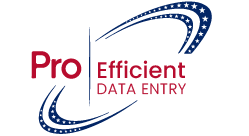In today’s data-driven world, transcription has become a vital component across multiple industries — from healthcare and legal to education and media. However, transcription alone isn’t enough. For businesses to truly benefit from their transcribed data, proficient data entry must complement it.

In this blog, we’ll explore how integrating data entry into transcription services enhances speed, accuracy, compliance, and workflow efficiency. Whether you’re transcribing legal depositions, medical records, academic interviews, or media content, mastering this combination is key to success.
What is Transcription?
Transcription is the process of converting spoken words from audio or video recordings into written, readable text. This includes:
- Meeting notes
- Interviews
- Webinars
- Legal proceedings
- Medical dictations
A high-quality transcription goes beyond typing what is heard—it requires strong grammar skills, active listening, and contextual understanding to capture nuances, technical terms, and speaker intent.
Why Proficient Data Entry Matters in Transcription
Proficient data entry involves accurate, consistent, and structured input of information into digital systems. When paired with transcription, it ensures that transcripts are not only readable but also:
- Properly formatted
- Classified with metadata
- Integrated into software systems (e.g., CRMs, EMRs, legal databases)
- Ready for retrieval and analysis
Key Advantages of Data Entry in Transcription:
✅ Improved Precision
Accents, background noise, and technical jargon can cause misinterpretation. Data entry specialists validate, spell-check, and format content to eliminate errors.
✅ Standardized Templates
After transcription, professionals format documents into templates for reports, databases, or content systems—making them user-friendly and searchable.
✅ Metadata Tagging
Speaker labels, timestamps, and topic tags help organize content, especially in legal, academic, or research transcription.
✅ Seamless Integration
Accurate data entry ensures compatibility with CRMs, EHRs, DMS platforms, and more, streamlining operations.
Industries That Benefit Most from This Integration
1. Healthcare
Medical transcription demands 100% accuracy due to regulatory compliance (HIPAA). Data entry ensures consistent records, coding, and privacy adherence.
2. Legal Sector
Court hearings, depositions, and client interviews require exact transcripts. Data entry helps in cataloging, case referencing, and compliance with legal standards.
3. Academia & Research
Interviews, group discussions, and lectures must be indexed and analyzed. Data entry allows for structured archives and fast retrieval.
4. Media & Journalism
Transcribing interviews or broadcasts? Data entry aids in formatting, metadata tagging, and content repurposing for publishing platforms.
Benefits of Merging Transcription with Proficient Data Entry
- 🚀 Faster Turnaround Times: Automation + human oversight means quicker delivery without sacrificing quality.
- ✅ Enhanced Data Quality: Double-verification minimizes errors.
- 📈 Scalable Workflows: Easily expand from 10 to 10,000 transcripts.
- 🔐 Better Data Security: NDA-bound professionals and secure systems protect sensitive data.
- 📋 Regulatory Compliance: Ensures GDPR, HIPAA, and ISO compliance for stored data.
Best Practices for Successful Integration
1. Leverage AI with Human Oversight
AI transcription software boosts speed. Pairing it with professional data entry ensures quality control and context accuracy.
2. Always Proofread
Use a two-step process—transcribe, then review and format with a data entry expert to eliminate inconsistencies.
3. Use Standardized Templates
Consistent formatting enhances readability and professional presentation.
4. Invest in Staff Training
Ongoing training ensures data entry teams stay updated on industry-specific terms, compliance regulations, and transcription tools.
Choosing the Right Transcription + Data Entry Service Provider
Look for a partner who offers:
- Proven industry experience
- 99%+ transcription accuracy
- Transparent pricing with no hidden fees
- Secure file transfer protocols
- Positive client reviews and case studies
💡 Pro Tip: Choose providers who offer both transcription and data entry services under one roof for seamless communication and integration.
Real-World Impact: A Case Example
A legal firm was struggling with scattered audio files, delayed case filings, and non-compliant records. After partnering with a provider offering combined transcription and data entry services:
- Turnaround time reduced by 50%
- Compliance audit scores improved
- File retrieval efficiency increased by 70%
This case underlines how combining both services drives tangible business outcomes.
Final Thoughts
Transcription is more than just converting audio to text—it’s about transforming spoken content into actionable, structured data. Proficient data entry bridges this gap, ensuring transcriptions are not only accurate but usable across platforms and industries.
Whether you operate in healthcare, law, education, or media, this integration streamlines workflows, improves compliance, and boosts operational efficiency.
Need help with transcription and data entry services tailored to your industry?
👉 Contact Proefficient Data Entry today to learn how we can optimize your processes and ensure data precision every step of the way.


Add a Comment